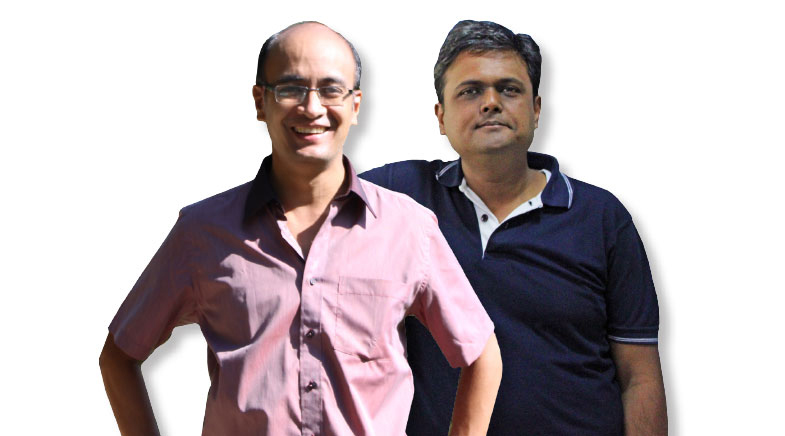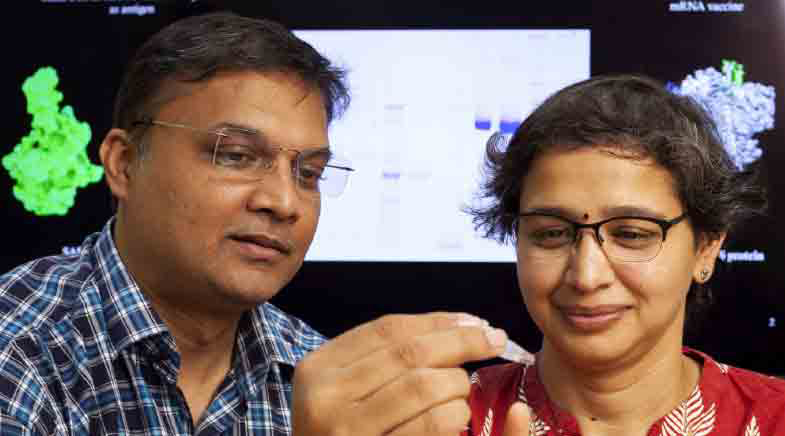In search of blue
-
- from Shaastra :: vol 01 edition 03 :: Sep - Oct 2021

An authoritative biography of blue gives a new tint to the ongoing quest for the rarest colour on Earth.
The first time he saw the colour, M.A. Subramanian could not believe his eyes. The U.S.-based professor had asked a graduate student to grind a trio of dull oxides and bake the mixture at around 1,200° Celsius. The goal was to make a multiferroic or high-efficiency electronic material. What stared back at him from the furnace the next day was a dazzling blue powder.
The solid-state chemist at Oregon State University, with a PhD from IIT Madras, had worked in DuPont for over 20 years. He recalled colleagues from the pigment division saying that it was hard to make a blue compound in the lab. His industry instincts kicked in. Though it was not multiferroic, he patented the material, which proved to be inert, non-toxic and heat-reflecting.
'Mas' Subramanian, it turns out, had discovered the first new blue pigment in more than two centuries. YInMn (pronounced Yin-Min) Blue - a mix of Yttrium (Y), Indium (In) and Manganese (Mn) - has captured the imagination of the creative community. In the U.S., YInMn Blue was approved for use in industrial coatings and plastics in 2017. It was marketed as paint earlier this year.
The story of YInMn Blue figures prominently in Blue: In search of Nature's Rarest Color, by Kai Kupferschmidt, a correspondent for Science magazine. The author writes engagingly of the science and aesthetics of blues in nature, the history of blue dyes and pigments, and the ongoing quest for blues. Viewing the world through the lens of his favourite colour, he presents his information in five sections: 'Stones', 'Seeing', 'Plants', 'Speaking', and 'Animals'.

The peacock on the book jacket represents the idea that most blue in nature is illusory. Blue-coloured birds, beetles and butterflies have tiny patterns on the surface of their bodies. These structures reflect light, so the blue wavelengths (380-500 nanometres) get exquisitely enhanced, while other wavelengths cancel out. Even the all-encompassing sky is not blue. Some plants make blue flowers and berries by modifying red pigments. There are a few blue minerals. Still, extracting a durable blue pigment from natural sources is difficult. Blue has always demanded ingenuity.
Before YInMn Blue, another blue pigment had wowed the world. Ultramarine, once worth its weight in gold, was processed from lapis lazuli found in the Hindu Kush mountains. Michelangelo used ultramarine to depict the blue of the heavens in the Sistine Chapel. Later, synthetic ultramarine became a mass commodity. People use it for mundane activities such as making white laundry appear whiter. Its manufacture, however, is not ecologically friendly. And other synthetic blues have their own shortcomings.
Scientists know how light interacts with the arrangement of atoms in an existing mineral to give it a distinct hue, but they cannot predict what colour any new material will be without actually making it in the lab. Having pinned down the structure of YInMn Blue, Subramanian's group is changing components of the pigment to try and create other hues.
Elsewhere, researchers are on a quest for blue food colourants from plants. Consumers are wary of the fact that a blue chemical - synthetic indigo - colours both their candy and jeans. Currently, the only source of natural blue is spirulina, an extract of blue algae, which is neither vibrant nor durable, Kupferschmidt writes. A British scientist has succeeded in making a safe and eye-catching blue from the petals of the butterfly pea flower, but the food industry needs a more durable colourant.
Most blue in nature is illusory. Even the all-encompassing sky is not blue. Some plants make blue flowers and berries by modifying red pigments.
Meanwhile, Suntory, the Japanese whisky manufacturer, is backing an effort to create a blue rose through genetic engineering. In over two decades, researcher Yoshikazu Tanaka has developed a mauve rose, and hopes to get to true blue before retirement.
Two sections of the book - 'Seeing' and 'Speaking' - deal with how we perceive and describe colour. Take the cornflower. It absorbs the red part of the spectrum from white sunlight and reflects (or rejects) the rest. The eye transforms the reflected light, which appears blue, into electrical signals for the brain to process. Language provides the beholder with the prescribed shade of colour. "Where then is the blue," Kupferschmidt muses philosophically.
But even the visually impaired can sense blue light. They grow more alert in its presence. So, what is its impact on the sighted, who are increasingly bathed in the blue glow of electronic devices, often well into the night? Can patients rest well in clinical wards, under artificial lights, rich in blue wavelengths? Such research is already changing internal lighting in homes and hospitals.
In the closing pages, when you learn that the Berlin-based author, born in 1982, has tested HIV-positive, you cannot help feeling blue. When he resolves to look out into the world more often, as if he were seeing all its colours for the very first time, you feel relieved, and even inspired. Thanks to this authoritative biography of blue, most curious readers will get a new understanding of the science of colour. Scientists too may begin to appreciate works of art.
These days, Subramanian accompanies his wife to art museums, to see what magic the old masters created - especially with blue pigments. YInMn Blue, he says, has enriched his life in more ways than one.
Vijaysree Venkatraman is a Boston-based science journalist.

@vijeescijo
Have a
story idea?
Tell us.
Do you have a recent research paper or an idea for a science/technology-themed article that you'd like to tell us about?
GET IN TOUCH














